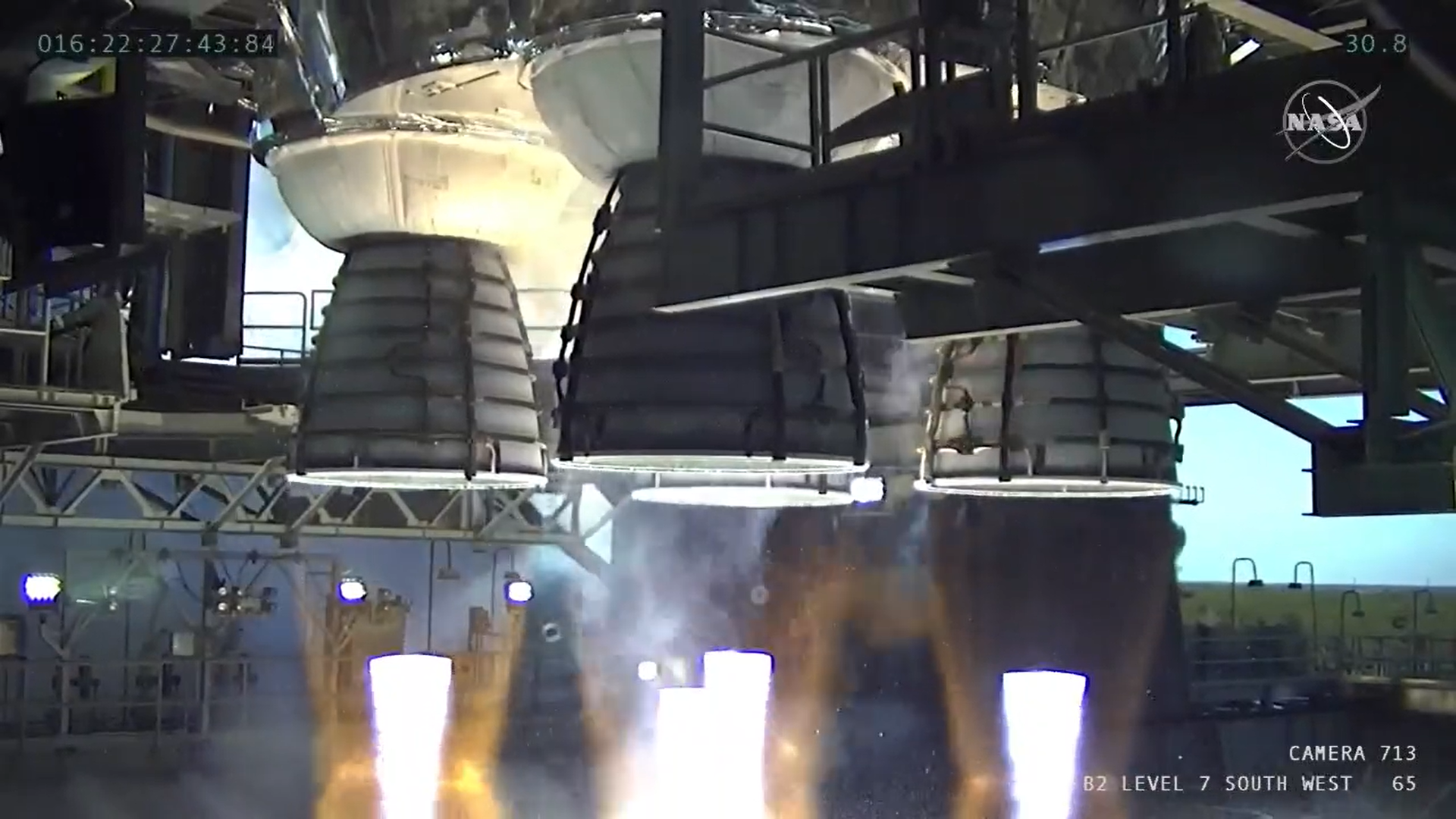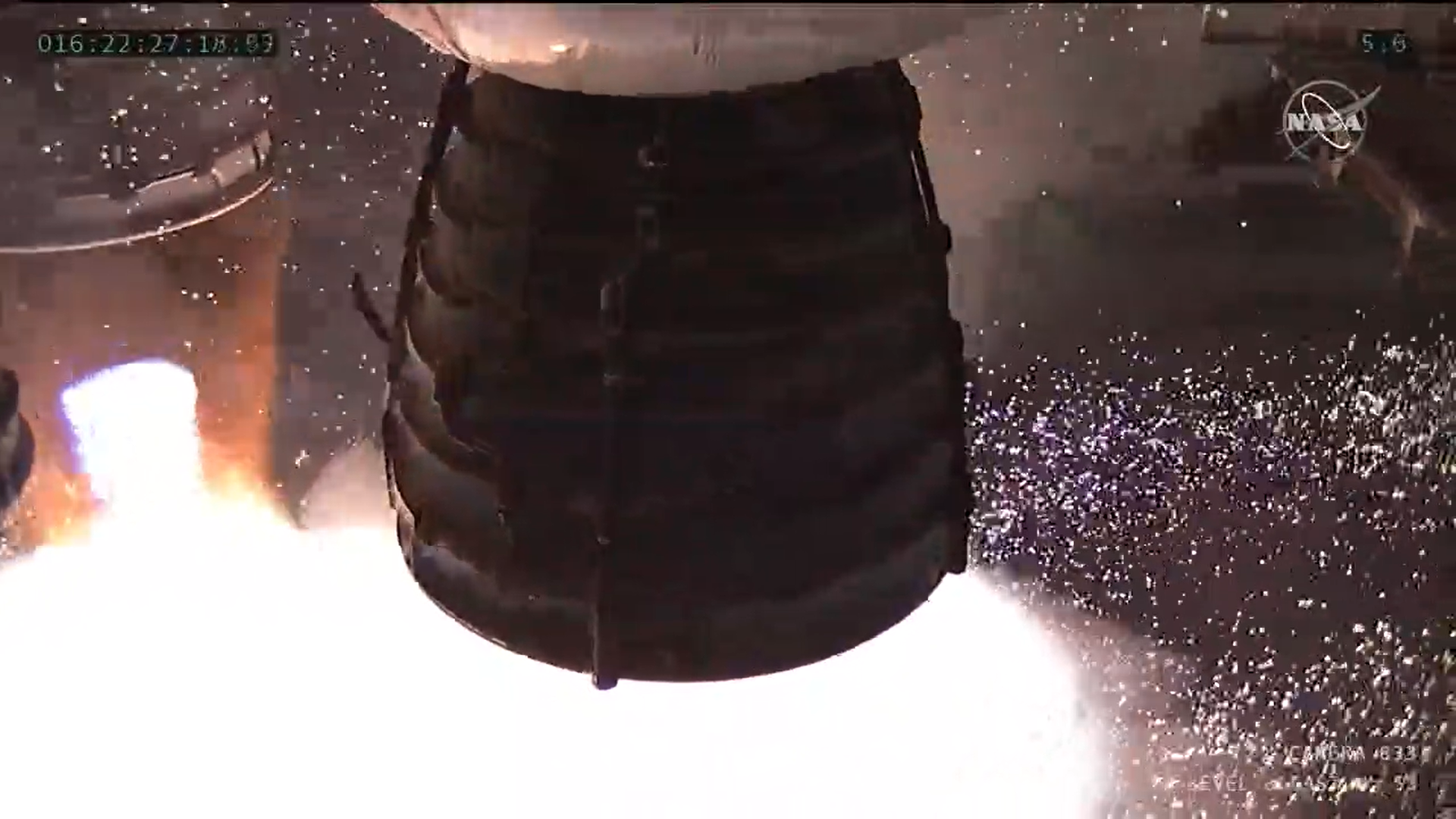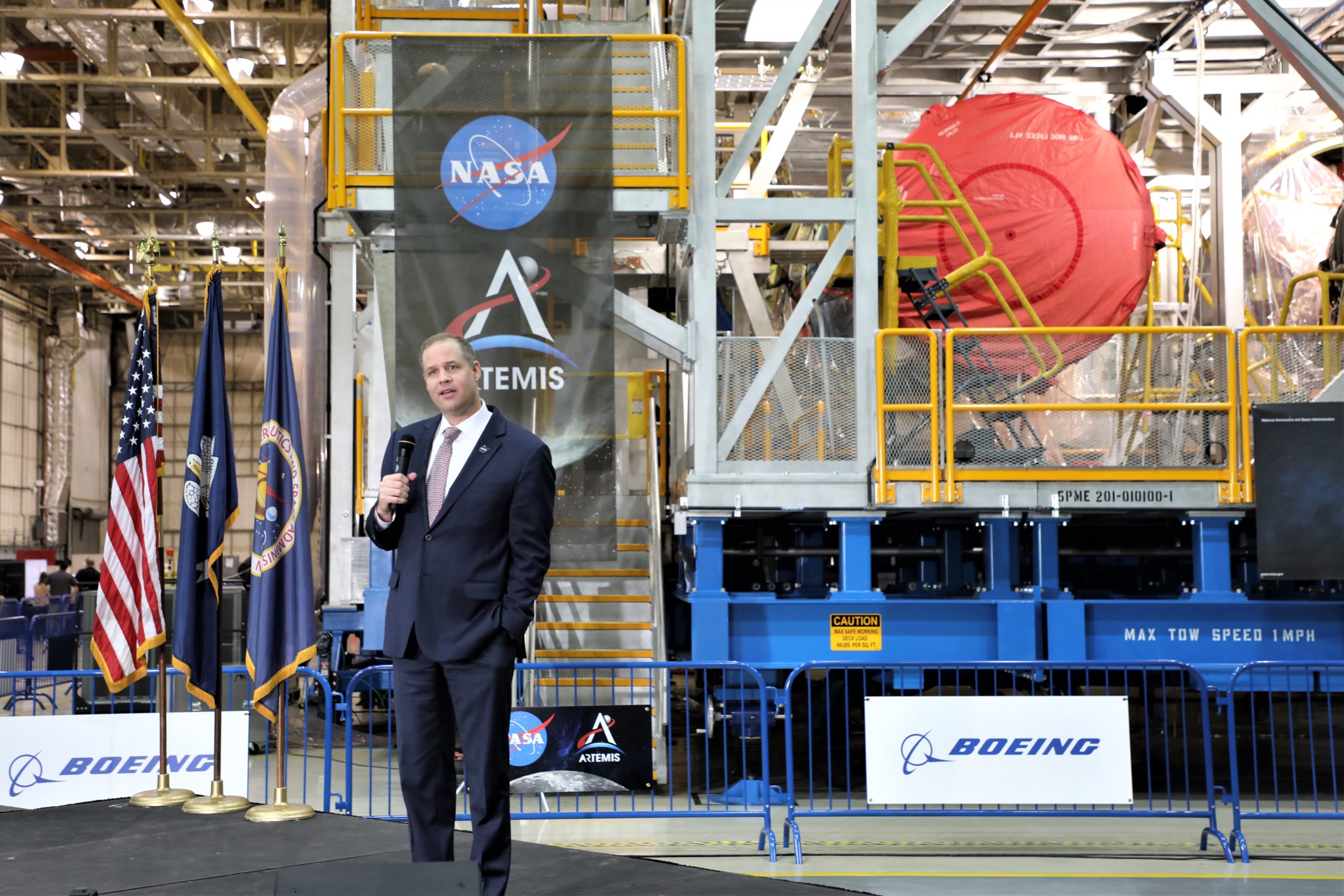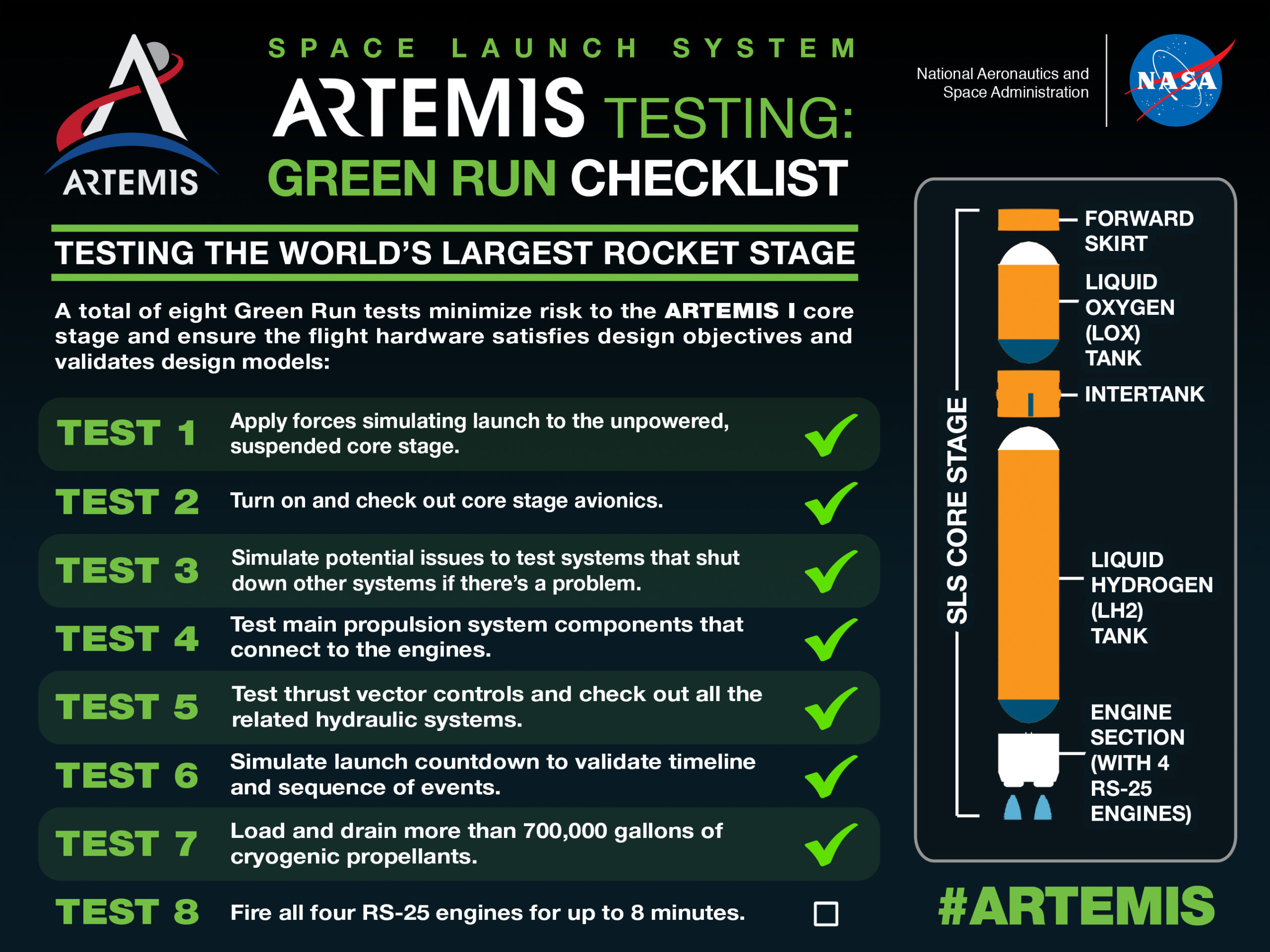
For SpaceUpClose.com & RocketSTEM
CAPE CANAVERAL, FL – NASA conducted the long awaited and absolutely critical Green Run hot fire test of all four engines on the core stage for the agency’s Space Launch System (SLS) moon rocket in Mississippi on Saturday, Jan. 16 but the test ended early when the engines shut down only about 1 minute into the planned full duration time of eight minutes.
NASA is now seeking to determine the cause of the premature engine shutdown of the agency’s mammoth Space Launch System (SLS) core stage quartet of engines at the base of the mighty Moon rocket at the agency’s Stennis Space Center near Bay St. Louis, Mississippi.
“Teams are assessing the data to determine what caused the early shutdown, and will determine a path forward,” said NASA.
All four Aerojet Rocketdyne RS-25 core stage engines – recycled from the space shuttle era – did successfully ignite as planned at 120-millisecond intervals at 5:27 p.m. ET (2227 GMT) on the B-2 Test Stand at Stennis Space Center and fired for 67 seconds.
Thus the test was a milestone achievement and marks a major step forward for SLS since NASA did collect a vast quantity of very helpful data.
In fact this test marked the first time that all four engines ignited simultaneously for the Boeing-built core stage.
However the root cause of the engine anomaly must be determined and reliable and robust fixes implemented.
The hot fire lasted only a little more than 1 minute and was far short of the full duration Green Run test NASA and prime contractor Boeing had sought in order to clear the core stage for refurbishment and then shipment by the Pegasus barge for arrival at NASA’s Kennedy Space Center (KSC) launch site on February 25.
“Saturday’s test was an important step forward to ensure that the core stage of the SLS rocket is ready for the Artemis I mission, and to carry crew on future missions,” said NASA Administrator Jim Bridenstine, who attended the test in a post test media briefing.
“Although the engines did not fire for the full duration, the team successfully worked through the countdown, ignited the engines, and gained valuable data to inform our path forward.”
"The test article that is behind us is also the flight hardware that will launch Orion to the Moon. This is unique. […] This article made the right decision to shut itself down." – Administrator @JimBridenstine on today's @NASA_SLS core stage test. pic.twitter.com/hv7mRx7gAn
— NASA (@NASA) January 17, 2021
Watch this NASA video of the test:
Watch all four @NASA_SLS core stage engines roar to life and shake the ground in Mississippi.
Teams are assessing the data on early engine shutdown. pic.twitter.com/U5bNqqbdZd
— NASA (@NASA) January 16, 2021

The hot fire test was planned to run full duration and simultaneously fire the four RS-25 engines for about 8 minutes or approximately 485 seconds on the B-2 test stand at Stennis and generate about 1.6 million pounds of thrust – fueled by cryogenic, or supercold, liquid oxygen (LOX) and liquid hydrogen (LH2) propellant fed into the fuel tanks from six propellant barges.
The full duration of eight minute was planned because its the same amount of time it will take to send the SLS rocket to space following launch from KSC.
Officials said they needed for the test to run at least about 250 seconds to obtain sufficient data to proceed ahead – at the pretest briefing.

This first SLS core stage is destined to launch the Artemis I mission to the Moon.
NASA had been targeting to launch Artemis 1 by late 2021 – if all had gone well with the Jan. 16 hot fire test.
The hot fire was to be the final test in the Green Run series of eight major tests that began about a year ago.
“For the test, the 212-foot core stage generated 1.6 million pounds of thrust, while anchored in the B-2 Test Stand at NASA’s Stennis Space Center near Bay St. Louis, Mississippi. The hot fire test included loading 733,000 pounds of liquid oxygen and liquid hydrogen – mirroring the launch countdown procedure – and igniting the engines,” NASA reported.
“Seeing all four engines ignite for the first time during the core stage hot fire test was a big milestone for the Space Launch System team” said John Honeycutt, the SLS program manager at NASA’s Marshall Space Flight Center in Huntsville, Alabama.
“We will analyze the data, and what we learned from today’s test will help us plan the right path forward for verifying this new core stage is ready for flight on the Artemis I mission.”
.@NASA_SLS program manager John Honeycutt provides a summary of today's rocket core stage test at @NASAStennis: pic.twitter.com/RwpFwoiEli
— NASA (@NASA) January 17, 2021
But the cause is not yet clear and NASA did not offer much in the way of explanations.
“When I left the team a little while ago, they were still beginning to pore through the data, and we will continue to do that over the next several days,” said Honeycutt.

The NASA, Boeing and Aerojet Rocketdyne team will need to inspect the core stage and engines and determine fixes and then decide the way forward and if another hot fire test should be conducted or not.
A delay in shipment to KSC seems almost certain – but is TBD at this point
Simultaneously team at KSC are already stacking the Artemis 1 SLS SRB boosters and have finished assembly of the Orion crew vehicle – see our upcoming story and photos.
Jim Bridenstine said it was to early to say if the early shutdown will delay launch of Artemis 1.
"I want people to be encouraged because the future is very bright, and certainly we're going to learn a lot from this test." – Administrator @JimBridenstine reflects on today's hot fire of the @NASA_SLS rocket core stage. pic.twitter.com/vYfpxr56nG
— NASA (@NASA) January 17, 2021
During the post test briefing I asked if NASA would proceed ahead with booster stacking and Orion fueling?
Here is the question I asked at the 8 PM Green Run post hot fire test briefing – kindly transcribed thx!! The answer as with the engine anomaly – is more analysis time needed to determine best way forward. The good news is – NASA got lots of good data today https://t.co/YtA9ItjRxv
— Ken Kremer🇺🇦🇩🇪🇺🇸🚀🧪 (@ken_kremer) January 17, 2021

Further details from NASA:
The Green Run series of tests began in January 2020, when the stage was delivered from NASA’s Michoud Assembly Facility in New Orleans and installed in the B-2 test stand at Stennis. The team completed the first of the eight tests in the Green Run series before standing down in March due to the ongoing coronavirus pandemic. After resuming work in May, the team worked through the remaining tests in the series, while also standing down periodically as six tropical storms or hurricanes affected the Gulf Coast. Each test built upon the previous test with increasing complexity to evaluate the stages’ sophisticated systems, and the hot fire test that lit up all four engines was the final test in the series.
“Stennis has not witnessed this level of power since the testing of Saturn V stages in the 1960s,” said Stennis Center Director Rick Gilbrech. “Stennis is the premier rocket propulsion facility that tested the Saturn V first and second stages that carried humans to the Moon during the Apollo Program, and now, this hot fire is exactly why we test like we fly and fly like we test. We will learn from today’s early shutdown, identify any corrections if needed, and move forward.”
In addition to analyzing the data, teams also will inspect the core stage and its four RS-25 engines before determining the next steps. Under the Artemis program, NASA is working to land the first woman and the next man on the Moon in 2024. SLS and the Orion spacecraft that will carry astronauts to space, along with the human landing system and the Gateway in orbit around the Moon, are NASA’s backbone for deep space exploration.
…

Here is test fire imagery from NASA:
Today, @NASA, @BoeingSpace, and @AerojetRdyne held the Green Run hot fire test.
Take a look at the imagery we captured of all four RS-25 engines of @NASA_SLS firing simultaneously at @NASAStennis. 📷 https://t.co/Usl68VINOW pic.twitter.com/vAlTSFp0kH
— NASA HQ PHOTO (@nasahqphoto) January 17, 2021
Watch our live and complete ‘Stay Curious’ Dec 14 and Dec. 30 , 2020 shows on many space topics including Artemis and human spaceflight
https://www.facebook.com/175507880819/videos/226784775573274
https://www.facebook.com/175507880819/videos/775199953071117
Video Caption: Return and Resurgence of US Human Space Flight: Learn about what’s new at the Cape with huge increase in launches including SpaceX Crew & Cargo Dragon and ULA Atlas & Delta IV Heavy launches and Holidays in Space as Space Journalists Dr. Ken Kremer and Jean Wright serve as co-hosts on ‘Stay Curious’ on the Dec. 14 edition hosted by American Space Museum and update you on the latest news from the Space Coast…all to bridge the space between us. Credit: Stay Curious/American Space Museum
Watch Ken’s continuing reports about NASA missions, SpaceX, Artemis, Starlink, Commercial Crew and Artemis and onsite for live reporting of upcoming and recent SpaceX and ULA launches including Demo-2, X-37B, Solar Orbiter, Mars 2020, NRO spysats and more at the Kennedy Space Center and Cape Canaveral Space Force Station.
Stay tuned here for Ken’s continuing Earth and Planetary science and human spaceflight news: www.kenkremer.com –www.spaceupclose.com – twitter @ken_kremer – email: ken at kenkremer.com
Dr. Kremer is a research scientist and journalist based in the KSC area, active in outreach and interviewed regularly on TV and radio about space topics.
………….
Ken’s photos are for sale and he is available for lectures and outreach events
Please consider supporting Ken’s work by donating at Patreon:
https://www.patreon.com/kenkremer

x



